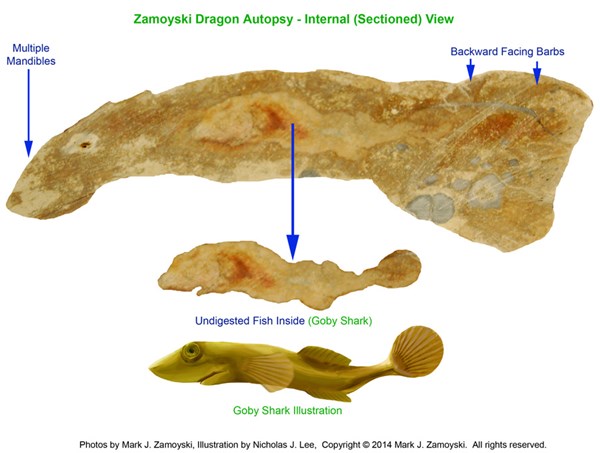San Jose, CA, April 25, 2014 (GLOBE NEWSWIRE) -- (http://www.myprgenie.com) -- Photos have just been released of a 250 million year old carnivorous dinosaur forerunner discovered in Northern Arizona.
The fossil was discovered by Mark Zamoyski, author of "On the Origin of Life and Biodiversity", a book that documents the transition from unicellular life to multicellular life.
The preservation of the entire body allowed the specimen to be autopsied (sectioned) to provide a unique glimpse of the internal anatomy of the era.
"To provide background context, Arizona was a shallow coastal ocean during the Permian period, when several extinction pulses rocked the earth. Each extinction pulse was followed by a sharp recovery pulse, similar in respects to a mini Cambrian explosion of life. Shallow oceans were the birthplace of life, and Arizona was at the right place at the right time. The Permian explosions of life introduced a new cast of characters that spawned the age of the dinosaurs" Zamoyski said.
"In context of this history, the reasonable inference is that this life form was part of a recovery pulse, and was killed and fossilized by a subsequent extinction event. A whole body fossil, that includes internal soft tissue preservation, can be sectioned (cut in half) to provide a snapshot of the internal molecular biology of the time. The underlying DNA can be inferred from the observable features resulting from expression of that DNA" said Zamoyski.
The photos show a 7" marine life form with a dragon like head on a fish like body. Sectioning reveals the life form was closer to a unicellular protist, as it had no bones. The stomach contents reveal an unchewed, undigested fish, implying the "Zamoyski Dragon" used a typical protist approach of swallow whole and digest. The undigested fish has been named "Goby Shark" because it has has features of both a goby fish and a shark.
"The segmented skin around the Zamoyski Dragon's head and the backward facing barbs at the top rear, inside the tail, indicate the presence of specialized cell types to make them, making this a multicellular life form. The backward facing barbs at the rear would likely lodge in a pursuer's throat, preventing swallowing and facilitating forward escape. They would be effective until a kill and chew predator came along" Zamoyski concluded.
More information and other photos are posted online at www.paleolife.info
Photos accompanying this release are available at:
http://www.globenewswire.com/newsroom/prs/?pkgid=24962
http://www.globenewswire.com/newsroom/prs/?pkgid=24963
http://www.globenewswire.com/newsroom/prs/?pkgid=24964
http://www.globenewswire.com/newsroom/prs/?pkgid=24965



